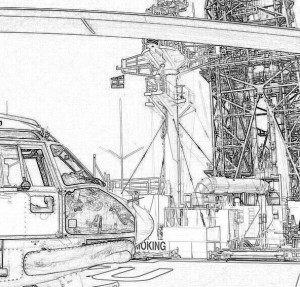In a session entitled “Resilience, helicopters and the challenge of transferring the workforce offshore” at Oil & Gas UK‘s first Annual Conference, attendees heard that the industry is now better prepared for major disruption. Past disruptions have included:
- The 2010 Eyjafjallajökull (aka ‘E15’) volcanic eruption in Iceland and the resulting volcanic ash fall out
- Two ditchings in 2012 due to a common airworthiness issue and the subsequent aircraft restrictions & unavailability (the subject of a recent AAIB report, discussed by Aerossurance previously).
Paul de Leeuw, head of Oil & Gas UK’s resilience planning taskforce said:
We have made some really good progress. We have a really good fact base established for the North Sea – we know how many people are flying, where they are flying from. The insight is really helpful.
In the UK Sector their are typically 16,000 people offshore at anyone time across 149 manned installations. A population of around 57,000 people travelled offshore last year with 900,000 outbound/inbound people movements and 96,000 helicopter flights.
The task force has also agreed a priority order for recovering workers stranded in the case that helicopters are limited in their ability to fly out to retrieve them. A number of innovative marine solutions for transporting workers offshore are being evaluated (see the Step Change in Safety‘s Marine Transfer Workgroup), such as ‘walk to work’ technology (as used, for example, by Chevron to support an upgrade programme on the Captain FPSO, as shown here). Marine assets were also used for a small period after the loss of an S-92A in Canada in 2009. However, de Leuuw added, there will “never be a replacement for helicopters”.
Duncan Trapp, vice president of safety at CHC Helicopter explained that time and effort spent in coordination between air operators and their clients, particularly through bodies such as Helicopter Safety Steering Group (HSSG) in the UK Sector, was vital in minimising impact of events affecting aviation.
One recent example of such cooperation was the work with Oil & Gas UK to understand the operational impact of the Civil Aviation Authority’s (CAA) proposed, but now abandoned, seating restriction that emerged from the CAA Review, and their CAP1145 report issued in February 2014.
Les Linklater, team leader for Step Change in Safety group said that HSSG had been temporarily become ineffective as membership swelled to 60. Part of this really indicated the desire for information across multiple shareholders but made decision making more difficult. Consequently there has been a refocus to a smaller, senior membership.
In relation to improving safety, Trapp highlighted the Joint Operators Review currently underway by the three main helicopter groups (CHC, Bristow and Avincis):
We need to overcome the traditional discomfort of sharing openly the status of business and the fear of competitive one-upmanship.
Major incidents are not the time to make financial gain or be clever or in the commercial department. Those are the times to truly get around the table and cooperate.
Trapp also explained how a new international trade body was being created for offshore helicopter operators.
The value of close cooperation and coordination is also demonstrated by the rapid progress being made with the design and introduction of Class A Emergency Breathing systems (as discussed by Aerossurance previously).
While the papers from this session are not currently on the Oil & Gas UK site, Linklater and Trapp did present at the Oil & Gas UK Aviation Seminar a few days earlier (as discussed by Aerossurance here):
Les Linklater’s Aviation Seminar presentation
Duncan Trapp’s Aviation Seminar presentation
Annual Conference press coverage
To discuss your resilience, how your business should prepare for aviation operational disruption in the North Sea or elsewhere globally and how Aerossurance can help you, please contact: enquiries@aerossurance.com
Follow us on LinkedIn for our latest updates.


Recent Comments